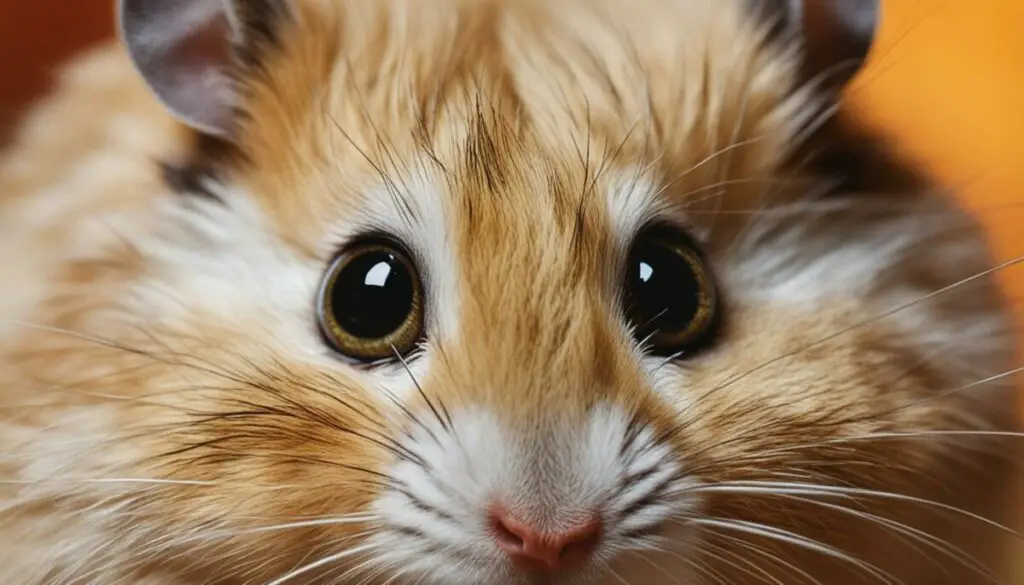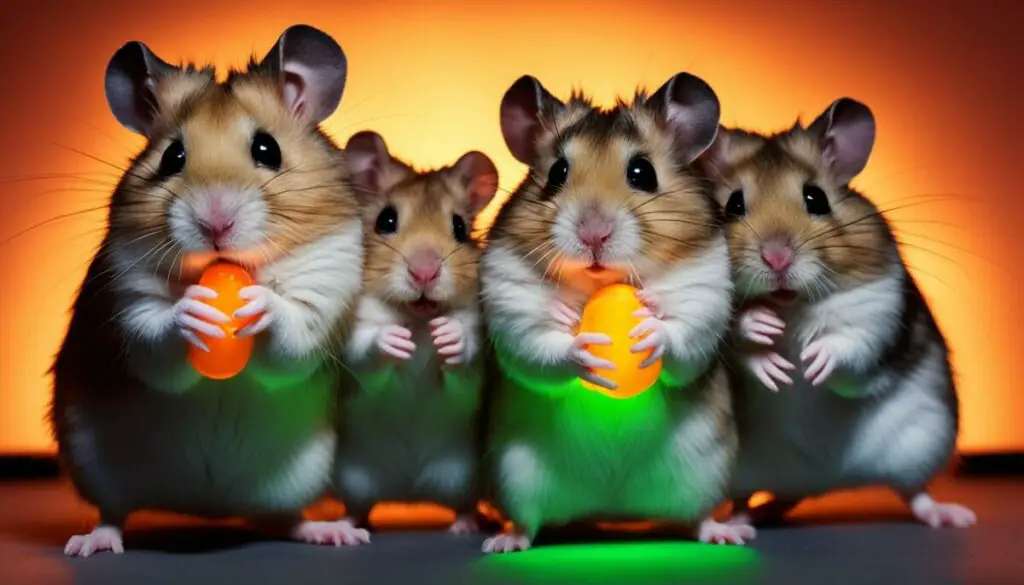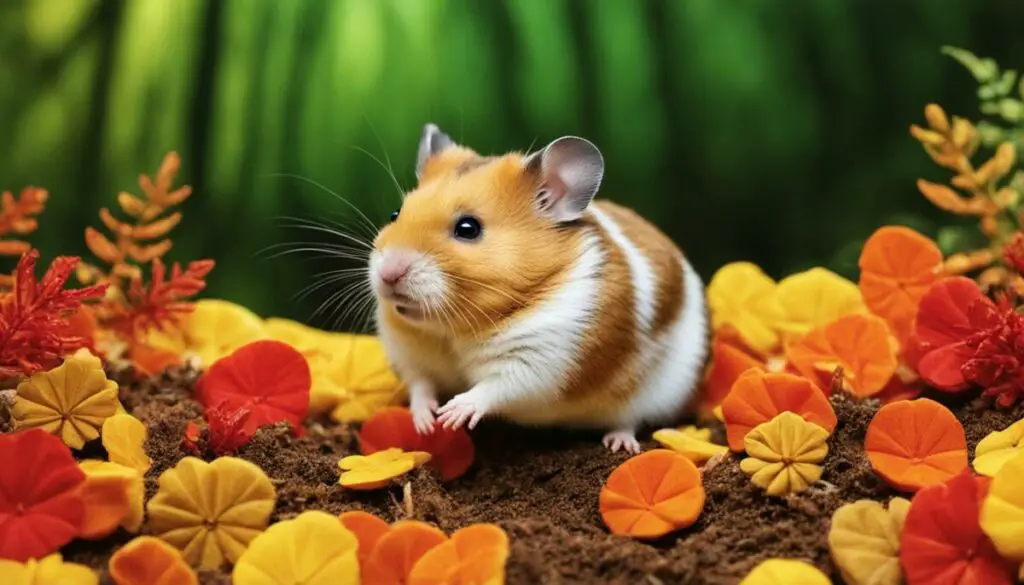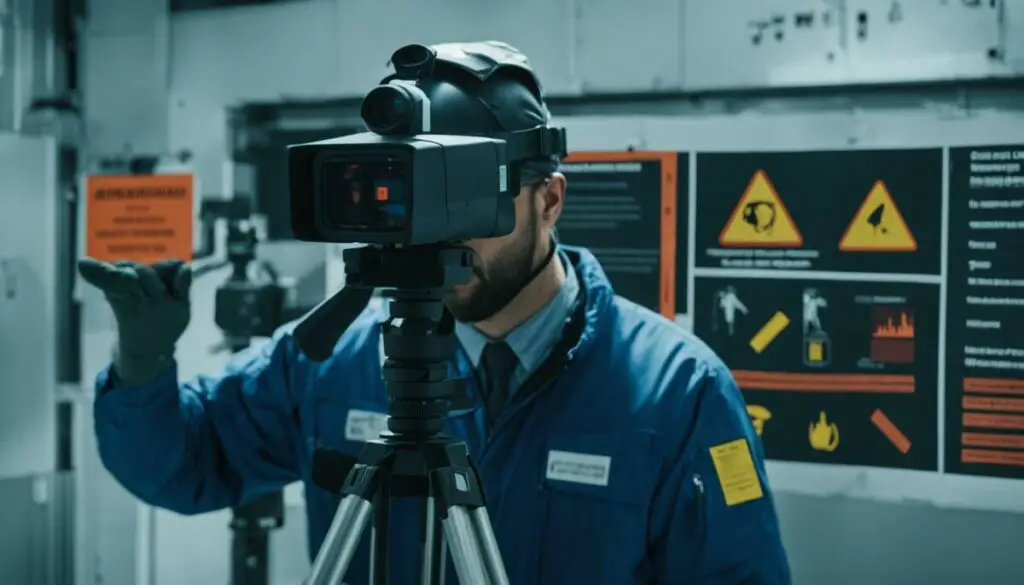Last Updated on 4 months by Francis
Hamsters, with their adorable and curious nature, have always been fascinating pets. But have you ever wondered if they have the ability to see infrared light? In this article, we will delve into the world of hamster vision and explore whether these small pets can detect infrared wavelengths.
Hamsters are known for their poor eyesight, but their visual capabilities go beyond just seeing in the visible light spectrum. Let’s take a closer look at their perception of light and whether they possess the intrinsic ability to detect infrared light and heat with their eyes.
Contents
Key Takeaways:
- Hamsters have poor eyesight and are nearsighted, making it challenging for them to see objects from a distance.
- They are most active during dawn and dusk when lighting conditions are low, but they primarily rely on their sense of smell and hearing to navigate their surroundings.
- While hamsters cannot see infrared light, exposure to intense light sources or infrared cameras can potentially harm their eyes and cause disorientation.
- Hamsters have better visibility in low light conditions, thanks to their abundance of rod cells, but they do not possess true night vision.
- They have limited color perception, primarily seeing shades of green and blue due to a higher concentration of rod cells over cone cells.
Hamsters’ Vision and Perception of Light

When it comes to vision, hamsters have a few limitations. They are nearsighted, which means they have difficulty seeing objects from a distance. Although their corneas may appear round, they are actually flat, hindering their ability to focus light and see clearly.
Hamsters are crepuscular animals, meaning they are most active during dawn and dusk when lighting conditions are low. This is when their vision is relatively better compared to bright daylight or complete darkness. However, it’s important to note that hamsters rely more on their exceptional sense of smell and acute hearing to navigate their surroundings.
“Hamsters have nearsighted vision, which limits their ability to see clearly at a distance.”
In low light conditions, hamsters are better equipped to perceive their environment. Their eyes contain a larger number of rod cells, which are responsible for detecting light and motion, enabling them to see relatively better during these times. However, it’s essential to remember that hamsters’ vision is still relatively poor compared to other animals.
Their reliance on other senses, such as smell and hearing, is particularly evident in their behavior. Hamsters use their sensitive noses to explore their surroundings and locate food, and their acute hearing helps them detect potential threats. These sensory abilities compensate for their relatively limited eyesight.
Hamsters’ Nocturnal Adaptations
Being crepuscular, hamsters have adaptations that allow them to thrive in low light conditions. These adaptations include larger eyes, which help gather more available light, and a tapetum lucidum, a reflective layer behind their retinas that enhances their ability to perceive dimly lit environments.
- Hamsters are crepuscular animals, most active during dawn and dusk.
- Their eyes adapt to low light conditions, allowing them to navigate their surroundings.
- Hamsters rely on smell and hearing to compensate for their limited eyesight.
While hamsters have their own unique ways of perceiving light and interacting with their environment, they are unable to see infrared light. In the next section, we will explore why hamsters cannot detect this form of light and how it can affect them.
Can Hamsters See Infrared Light?

Hamsters may have limited visibility, but their ability to see infrared light is non-existent. Infrared light falls within the invisible part of the light spectrum, and hamsters lack the necessary visual receptors to detect it. Their retinal cones are not sensitive to infrared wavelengths, preventing them from perceiving this form of light.
However, it is important to note that exposure to infrared light can still affect hamsters. When exposed to infrared radiation, hamsters can become disoriented or agitated, as this type of light is outside their visual perception. It is crucial to consider a suitable environment for hamsters, ensuring they are not subjected to excessive infrared light.
Even though hamsters are unable to see infrared light, they possess other remarkable senses that allow them to navigate their surroundings. Their acute sense of smell and excellent hearing compensate for their visual limitations.
Hamsters’ Sensitivity to Light

Hamsters are beloved pets known for their adorable antics and lovable nature. However, it’s important to understand that these little creatures have specific needs, including their sensitivity to light. Bright lights can have a significant impact on hamsters and their overall well-being.
When exposed to strong infrared radiation or other intense forms of light, hamsters can experience discomfort and potential harm to their delicate eyes. They may become disoriented, stressed, or agitated, leading to behavioral changes or health issues. It’s crucial to exercise caution when using infrared cameras or any other sources of intense light around hamsters to avoid unnecessary distress.
Dogs, cats, and other animals with pre-existing eye conditions or heightened sensitivity to light are even more susceptible to the adverse effects of bright lights. Therefore, it’s essential to consider the impact of lighting on the entire household and take appropriate measures to ensure the comfort and well-being of all pets.
Protecting the eyesight of our furry friends is of utmost importance. By being mindful of their sensitivity to light, we can create a safe and comfortable environment for our hamsters to thrive in. Here are some tips to consider:
- Provide adequate shade: Create a living space for your hamster that offers areas of shade where they can retreat and rest without exposure to bright lights.
- Use soft, diffused lighting: Opt for soft, dim lighting in the room where your hamster resides to mimic their natural habitat. This can help them feel more secure and minimize any issues related to light sensitivity.
- Avoid direct exposure: Ensure that your hamster’s habitat is not placed directly under or in front of bright light sources, such as windows or lamps. This will prevent excessive exposure to intense light.
Remember, hamsters rely on their senses of smell and hearing more than their visual perception. While light plays a role in their environment, it’s crucial to consider their unique needs and ensure that the lighting conditions are suitable for their well-being.
If you have concerns about your hamster’s sensitivity to light or any changes in their behavior, it’s always best to consult with a veterinarian who can provide guidance and address any health issues that may arise.
Creating an environment that takes into account hamsters’ sensitivity to light is an important aspect of their care and well-being. By being mindful and implementing appropriate measures, we can help our furry friends lead happy and healthy lives.
Hamsters’ Night Vision

While hamsters have limited visual abilities, they possess better vision in low light conditions. Their eyes are equipped with millions of rod cells, which are specialized photoreceptor cells responsible for detecting light waves. These rod cells enable hamsters to perceive their surroundings when lighting conditions are dim, especially during dawn and dusk.
However, it’s important to note that hamsters do not possess true night vision like cats or owls. Their ability to see in complete darkness is subpar, and they rely more on their other senses, such as their keen sense of smell and hearing, to navigate their environment when light is absent.
Here’s an image to demonstrate the hamsters’ ability to see in low light conditions:
Hamsters’ Color Perception

While hamsters have limited color vision, they can perceive certain shades of green and blue. Their visual system is dominated by rod cells, which are responsible for low-light vision, rather than cone cells, which are responsible for color vision in humans. As a result, hamsters have difficulty distinguishing warmer colors and perceiving the full range of colors that humans can see.
Hamsters’ color perception is influenced by their evolutionary adaptations as crepuscular animals, primarily active at dawn and dusk. Their vision is optimized for detecting movement and navigating in low light conditions rather than discriminating between different colors.
| Color Perception | Explanation |
|---|---|
| Green | Hamsters can detect shades of green, but the perception may be limited compared to humans. |
| Blue | Hamsters can perceive blue colors to some extent, although the range of blues they recognize may be narrower than what humans see. |
| Red, Orange, and Warm Colors | Hamsters have difficulty perceiving warm colors, such as red and orange, due to their limited color vision. |
It is important to consider hamsters’ color perception when choosing toys, bedding, and cage decorations for them. Opting for visually stimulating elements in shades of green and blue can enhance their environment and engage their natural instincts.
“Hamsters rely more on their sense of smell, hearing, and touch to explore and interact with the world around them. While color perception is limited, these curious creatures still lead fulfilling lives with their unique sensory abilities.”
Understanding hamsters’ color vision helps us create environments that cater to their specific needs and preferences. By providing suitable colors and stimulating their other senses, we can ensure a comfortable and enriching experience for these beloved pets.
Hamsters’ Interaction with Humans

Hamsters have unique ways of perceiving and interacting with humans. Despite their poor eyesight, hamsters rely on their other senses, such as smell and hearing, to recognize and respond to their owners. Let’s explore how hamsters perceive humans and their fascinating responses to human presence.
How do hamsters see humans?
Due to their limited eyesight, hamsters may not be able to see humans clearly unless they are very close. Their eyes are not designed to focus on distant objects, so they rely on other cues to identify humans. However, hamsters have a keen sense of smell, and they can recognize their owners by scent.
Hamsters recognizing their owners
Hamsters have a remarkable ability to recognize their owners through scent. They have a highly developed sense of smell and can differentiate between different individuals based on the unique scent they emit. This is why it’s important to handle hamsters with clean hands and avoid strong fragrances that could confuse or mask their owner’s scent.
“Hamsters have a remarkable ability to recognize their owners through scent.”
Hamsters’ response to human presence
When humans are near, hamsters may exhibit various responses based on their individual personality and previous experiences. Some hamsters may become more alert and curious, while others may retreat to their burrows or hideouts. It’s essential to approach hamsters slowly and speak in a calm, gentle tone to help them feel comfortable and secure.
In addition to smell, hamsters are highly attuned to sounds. They can recognize familiar voices and may respond to their owners by chirping, squeaking, or even climbing on their hands when they feel safe and comfortable.
| Hamsters’ Interaction with Humans | Key Points |
|---|---|
| Hamsters’ Sight | Hamsters have poor eyesight and rely on other senses to recognize humans. |
| Recognition through Scent | Hamsters can recognize their owners by scent due to their highly developed sense of smell. |
| Varied Responses | Hamsters may exhibit different responses to human presence, such as curiosity or retreating to hiding spots. |
Throughout the interaction, it’s crucial to be patient and gentle with hamsters, allowing them to acclimate to human presence at their own pace. Building trust and understanding with these small, curious creatures can create a rewarding bond between hamsters and their owners.
Hamsters’ Eye Health and Blindness
Hamsters, just like any living creatures, can face eye health issues that may lead to vision impairment or blindness. It is essential for hamster owners to be aware of common eye problems and provide necessary care to maintain their pets’ eye health.
Eye Infections and Injuries
Hamsters are susceptible to eye infections caused by bacteria, viruses, or even foreign objects entering their eyes. These infections can cause redness, discharge, and discomfort. Additionally, hamsters are prone to eye injuries due to accidental scratching, sharp objects, or rough handling. Always handle hamsters gently and avoid potentially hazardous objects in their environment.
Signs of Blindness
A visually impaired or blind hamster may display various signs indicating the loss of vision. Some common signs include difficulty finding objects, bumping into things, and cloudy eyes. If you observe these symptoms in your hamster, seeking veterinary care is crucial.
Genetic Factors and Blindness
In some cases, hamsters may be born blind due to genetic factors. Certain hamster breeds or specific genetic variations may result in congenital blindness. If you have a hamster with a known genetic predisposition to blindness, extra care and precautions should be taken to ensure their well-being.
Monitoring and Veterinary Care
Regularly monitoring your hamster’s eye health is important for early detection and prompt treatment of any eye problems. If you notice any changes in your hamster’s eyes, such as redness, discharge, or unusual behavior, consult a veterinarian who has experience with small animals.
Common Eye Problems in Hamsters
| Eye Problem | Description |
|---|---|
| Eye Infections | Bacterial or viral infections causing redness and discharge in the eyes. |
| Eye Injuries | Accidental scratches, foreign objects, or rough handling leading to eye trauma. |
| Cataracts | Clouding of the lens, resulting in impaired vision or blindness. |
| Corneal Ulcers | Open sores on the cornea, causing pain, redness, and potential vision loss. |
| Glaucoma | Increased pressure within the eye, leading to irreversible damage and vision loss. |
It is important to remember that hamsters are delicate animals, and their eye health should not be neglected. Timely intervention and proper care can help prevent or manage eye problems, ensuring a better quality of life for your furry friend.
Safety Precautions with Infrared Cameras

When using infrared cameras around pets, including hamsters, it is crucial to prioritize their safety and well-being. By taking appropriate safety precautions, you can ensure that the use of infrared cameras does not harm your furry friends.
Avoid direct exposure to the eyes: It is imperative to avoid pointing the camera or the infrared light directly into the eyes of any animal. The intense light emitted by an infrared camera can be harmful and cause discomfort.
Maintain a safe distance: Keep the infrared camera at a safe distance while capturing images or videos. This distance will help minimize the impact of the infrared light on your pets, preventing any potential harm or distress.
Consider the sensitivity of pets: Different animals may react differently to infrared radiation. For example, birds are known to be particularly sensitive to this type of light. Therefore, it is crucial to be aware of the specific sensitivities of your pets when using an infrared camera.
Consult with a veterinarian: Before incorporating infrared cameras into your pet monitoring routine, it is advisable to consult with a veterinarian. They can provide valuable guidance and ensure that the use of infrared cameras aligns with your pets’ health and safety.
Ensuring the safety of your pets should always be a top priority. By following these safety precautions, you can confidently use infrared cameras around your pets, including hamsters, without the risk of harm.
The Importance of Dim Lighting for Hamsters
Hamsters have a natural preference for dim lighting conditions, as their sensitive eyes are easily affected by bright lights. Mimicking their natural habitat by providing dim lighting can help create a more comfortable and secure environment for these small pets.
When hamsters are exposed to bright lights, it can cause them to feel stressed or overwhelmed. Dim lighting, on the other hand, helps to create a calm and soothing atmosphere that aligns with their natural instincts. It allows hamsters to feel more at ease and promotes their overall well-being.
One of the ways to achieve dim lighting is by using red or low-intensity lights in the hamster’s enclosure. Red lights have a longer wavelength, making them less harsh and gentler on the hamster’s eyes. This type of lighting simulates the natural low light conditions that hamsters prefer, such as dawn and dusk.
Using dim lighting not only benefits the hamster’s visual comfort but also helps regulate their natural sleep-wake cycle. Hamsters are crepuscular animals, meaning they are most active during twilight periods when lighting conditions are low. Providing dim lighting in their enclosure can help support their natural activity pattern and promote healthier behavioral patterns.
The Benefits of Dim Lighting for Hamsters:
- Reduces stress and promotes relaxation
- Mimics natural low light conditions preferred by hamsters
- Creates a calm and soothing environment
- Regulates the hamster’s sleep-wake cycle
- Supports healthier behavioral patterns
Remember, hamsters rely on their sense of smell and hearing more than their vision to navigate their surroundings. Providing appropriate lighting that aligns with their preferences is crucial for their well-being. So, consider incorporating dim lighting in your hamster’s habitat to create a comfortable and inviting space for them.
Observing Hamsters’ Behavior in Low Light
Observing hamsters in low light conditions can provide valuable insights into their natural behavior and activities. As nocturnal animals, hamsters are more active at night and may exhibit different behaviors in the dark compared to when they are exposed to brighter lighting conditions.
Using appropriate lighting techniques can allow owners to watch their hamsters at night without disturbing their natural routines. One method is to use red lights, as hamsters have limited sensitivity to this color and it doesn’t disrupt their natural behavior. This means you can observe your hamster without causing them stress or interrupting their regular activities.
Another option for observing hamsters in low light is to utilize night vision cameras. These cameras are equipped with technology that allows for clear visibility even in the absence of adequate lighting. Night vision cameras are particularly useful for capturing hamsters’ behavior without causing any disruption, as they do not emit a noticeable light source.
By providing the opportunity to observe hamsters in low light conditions, owners can gain a better understanding of their pets’ nighttime habits. This includes witnessing their exploration, burrowing, grooming, playing, and other natural behaviors that might go unnoticed during the day.
It is important to note that while observing hamsters at night is enjoyable and informative, it is essential to respect their need for darkness and provide them with a quiet and peaceful environment during their active hours.
Conclusion
In conclusion, hamsters have poor eyesight and lack the ability to see infrared light. However, they compensate for this limitation by relying on their other senses, such as their keen sense of smell and hearing, to navigate their surroundings. It is important for hamster owners to understand their pets’ visual limitations and provide suitable lighting conditions to promote their well-being.
While hamsters cannot see infrared light, they are sensitive to bright lights and may be affected by exposure to intense light sources. It is crucial to exercise caution when using infrared cameras or other forms of intense light around these small pets to avoid potential harm to their eyes.
If there are concerns about a hamster’s eyesight or behavior, it is advisable to consult with a veterinarian. They can provide expert guidance and ensure the overall health and welfare of your furry friend. By being mindful of their visual limitations and providing suitable care, you can create a safe and comfortable environment for your hamster to thrive in.
FAQ
Can hamsters see infrared light?
No, hamsters cannot see infrared light. They lack the visual receptors to detect it.
How is the vision of hamsters?
Hamsters have nearsighted vision and rely more on their sense of smell and hearing.
Do hamsters have night vision?
While hamsters have better vision in low light conditions, they do not have true night vision.
Can hamsters see colors?
Hamsters have limited color perception and can only see shades of green and blue.
How do hamsters interact with humans?
Hamsters rely more on their sense of smell and hearing to identify and respond to their owners.
Can hamsters go blind?
Yes, hamsters can develop eye infections, injuries, and diseases that can lead to blindness.
What are the safety precautions with infrared cameras?
When using infrared cameras around pets, it is important to avoid pointing the camera or the infrared light directly into their eyes.
Do hamsters prefer dim lighting?
Yes, hamsters prefer dim lighting conditions as it mimics their natural environment and helps them feel more secure.
How can observing hamsters in low light conditions be beneficial?
Observing hamsters in low light conditions can provide insights into their natural behavior and activities.









